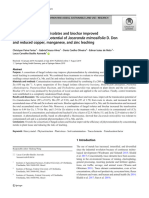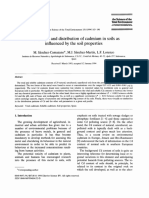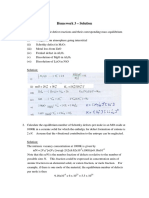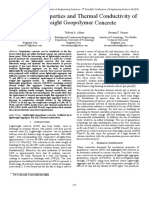Simb Glomalin
Uploaded by
Patricia Lopes LealSimb Glomalin
Uploaded by
Patricia Lopes LealGLOMALIN CONTENT AS INDICATOR OF REHABILITATION OF SOILS CONTAMINATED WITH HEAVY METALS
SOUZA, M.G.; PRADO, I.G.O.; SANTOS, J.V.; LEAL, P.L.; DE CARVALHO, F.; MOREIRA, F.M.S.; SIQUEIRA, J. O. Departamento de Cincia do Solo, Universidade Federal de Lavras - UFLA, Lavras, Minas Gerais, Brasil
INTRODUCTION
The contribution of arbuscular mycorrhizal fungi (AMF) to plant growth in soils contaminated with heavy metals is related to several features, including the production of an insoluble glycoprotein denominated glomalin, which is abundantly produced by the hyphae of some AMF and is able to retain large amounts of heavy metals. Therefore, has been suggested that measurement of soil glomalin might represent an important indicator of the changes associated with the use of soils and also rehabilitation because changes in vegetation cover directly influence the soil AMF communities and the quantity and quality of the compounds that they produce, such as glomalin. In Brazil, a research of glomalin is recent and in general, there are few studies in the literature on assessment of glomalin in soils of the tropics.
Figure 1. Partial view and representation of the soil sampling sites (R = plantation rows; BR = between plantation rows; Ec = E. camaldulensis; Bd = B. decumbens) in areas contaminated with heavy metals after use of the rehabilitation systems (S1 and S2), the non-rehabilitated contaminated sites (NR) and the non-contaminated sites [Cerrado (C) and Pasture (P)].
OBJECTIVES
The aim of this study was to quantify the content of total BRSP (Bradford-reactive soil protein) and EE-BRSP (easily extractable Bradford-reactive soil protein) from soil contaminated with zinc (Zn), cadmium (Cd), copper (Cu), and lead (Pb) under different rehabilitation systems.
Heavy Metals
Zn total (mg kg-1) (1) Zn soluble (mg kg-1) (2) Cu total (mg kg-1) (1) Cu soluble (mg kg-1) (2) Pb total (mg kg-1) (1) Pb soluble (mg kg-1) (2) Cd total (mg kg-1) (1) Cd soluble (mg kg-1) (2)
(1)Mehlich-1; (2)USEPA
RESULTS
Table 1 Total and soluble heavy metal content of the soil in areas of study
Ec-R
3805 2866 189 139 77 35 19 18,9
Ec-BR
8673 6680 511 456 139 77,3 37 37
EcB-R
574 258 10 7,2 32 15,6 6 4,8
EcB-BR
581 332 23 8 50 16,6 10 5,8
NR
47910 13695 738 343 6488 32 1207 565
C
23 1,8 18 1,4 15 <2,0 0,06 <0,02
P
17 3,6 14 2,6 7 <2,0 0,03 <0,02
MATERIAL AND METHODS
Soil samples were collected from sites at the Zn processing and industrialization unit of Minas Gerais Metal Company (Companhia Mineira de Metais - CMM), which is located in the municipality of Trs Marias (Minas Gerais MG Brazil). Two areas that were contaminated with heavy metals and that had been subjected to rehabilitation systems for seven to eight years were sampled. The systems included replacement of a part of the contaminated soil with non-contaminated borrow soil and planting of Eucalyptus camaldulensis with and without sowing of Brachiaria decumbens. For the purpose of comparison, a contaminated non-rehabilitated (NR) and two non-contaminated areas, Cerrado (C) and pasture (P) were used (Figure1). Soil samples were collected at a depth of 0-20 cm and included 10 composite samples that were originated from five single samples at plantation rows and in-between the rows. Five composite samples were collected at the NR, C, and P sites for a total of 55 experimental plots. The soluble heavy metal content of Zn, Cu, Cd, and Pb were extracted using Mehlich-1 solution (aqua regia as the extractor for soil heavy metals) and the total heavy metal content was determined using the USEPA 3051 method. The BRSP and EE-BRSP contents were determined using sodium citrate as extraction solution added to 1 g of soil followed by autoclaving and centrifugation. Coomassie Brilliant Blue G-250 and bovine serum albumin (BSA) were used to generate the standard curve. Readings were performed on a spectrophotometer at 595 nm.
3051
3 2.5 2 b 1.5 1 0.5 0 Ec-R Ec-BR EcB-R EcB-BR EE-BRSP dD NR BRSP P C bB cC b b B A A a A
Figure 2 - Total BRSP and easily extractable glomalin (EE-BRSP) contents of the soil in areas of study. Uppercase letters = comparison of BRSP values; lowercase letters = comparison of EE-BRSP values. Bars with the same letter do not differ on ScottKnott test (P < 0.05).
CONCLUSIONS
The glomalin levels were negatively correlated with the concentrations of heavy metals in the soil, suggesting that these attributes of communities of mycorrhizal fungi can be considered good indicators of rehabilitation of soils contaminated with Zn, Cu, Pb and Cd.
Support:
You might also like
- Agriculture Journal Copper Accumulation in Leucaena Leucocephala by Mycorrhizae Glomus Sp. Zac-19 in Symbiosis With RhizobiumNo ratings yetAgriculture Journal Copper Accumulation in Leucaena Leucocephala by Mycorrhizae Glomus Sp. Zac-19 in Symbiosis With Rhizobium10 pages
- Tolerance of Grasses To Heavy Metals and Microbial Functional Diversity in Soils Contaminated With Copper Mine TailingsNo ratings yetTolerance of Grasses To Heavy Metals and Microbial Functional Diversity in Soils Contaminated With Copper Mine Tailings8 pages
- Soils as a Key Component of the Critical Zone 4: Soils and Water QualityFrom EverandSoils as a Key Component of the Critical Zone 4: Soils and Water QualityGuilhem BourriéNo ratings yet
- Risk Analysis of Metals in Soil From A Restored Coal Mining AreaNo ratings yetRisk Analysis of Metals in Soil From A Restored Coal Mining Area5 pages
- Akoto Et Al (2008) Heavy Metals Pollution in Surface Soils in The Vicinity of Abandoned Railway Servicing Workshop in KumasiNo ratings yetAkoto Et Al (2008) Heavy Metals Pollution in Surface Soils in The Vicinity of Abandoned Railway Servicing Workshop in Kumasi6 pages
- Original Article /artículo Original: Muhlenbergia Angustata (Poaceae), Puno, PerúNo ratings yetOriginal Article /artículo Original: Muhlenbergia Angustata (Poaceae), Puno, Perú10 pages
- Biosorption of Copper Zinc and Chromium From Aqueous Solution by Fungal StrainsNo ratings yetBiosorption of Copper Zinc and Chromium From Aqueous Solution by Fungal Strains9 pages
- Some Physico-Chemical and Bacteriological Characteristics of Soil Samples Around Calabar Metropolis, Cross River State, NigeriaNo ratings yetSome Physico-Chemical and Bacteriological Characteristics of Soil Samples Around Calabar Metropolis, Cross River State, Nigeria7 pages
- Soil Contamination by Heavy Metals Measurements From A Closed Unlined LandfillNo ratings yetSoil Contamination by Heavy Metals Measurements From A Closed Unlined Landfill7 pages
- Effect of Long-Term Zinc Pollution On Soil Microbial CommunityNo ratings yetEffect of Long-Term Zinc Pollution On Soil Microbial Community6 pages
- A Consortium of Fungal Isolates and Biochar Improved The Phytoremediation Potential of Jacaranda Mimosifolia D. Don and Reduced Copper, Manganese, and Zinc LeachingNo ratings yetA Consortium of Fungal Isolates and Biochar Improved The Phytoremediation Potential of Jacaranda Mimosifolia D. Don and Reduced Copper, Manganese, and Zinc Leaching12 pages
- Bioaccumulation of Heavy Metals by Selected Plant Species From Uranium Mining Dumps in The Sudety MTS., Poland PolandNo ratings yetBioaccumulation of Heavy Metals by Selected Plant Species From Uranium Mining Dumps in The Sudety MTS., Poland Poland8 pages
- 1993 Kamajano, The Content and Distribution of Cadmium in Soils As Influenced by The Soil PropertiesNo ratings yet1993 Kamajano, The Content and Distribution of Cadmium in Soils As Influenced by The Soil Properties8 pages
- Biochar Application To Metal-Contaminated Soil: Evaluating of CD, Cu, PB and ZN Sorption Behavior Using Single-And Multi-Element Sorption ExperimentNo ratings yetBiochar Application To Metal-Contaminated Soil: Evaluating of CD, Cu, PB and ZN Sorption Behavior Using Single-And Multi-Element Sorption Experiment9 pages
- Trifolium Repens.: Exhibit 1: Experiment 1 - Effect of Different Arbuscular Mycorrhizal Fungi On HeavyNo ratings yetTrifolium Repens.: Exhibit 1: Experiment 1 - Effect of Different Arbuscular Mycorrhizal Fungi On Heavy9 pages
- Immobilisation of Cu, PB and ZN in Scrap Metal Yard Soil Using Selected Waste MaterialsNo ratings yetImmobilisation of Cu, PB and ZN in Scrap Metal Yard Soil Using Selected Waste Materials6 pages
- Soils as a Key Component of the Critical Zone 5: Degradation and RehabilitationFrom EverandSoils as a Key Component of the Critical Zone 5: Degradation and RehabilitationChristian ValentinNo ratings yet
- PR2 - RESEARCH PROPOSAL - Potential of Nile Tilapia (Oreochromis Niloticus) Scale As An Adsorption of Heavy Metals Lead (PB) in Soil EnvironmentNo ratings yetPR2 - RESEARCH PROPOSAL - Potential of Nile Tilapia (Oreochromis Niloticus) Scale As An Adsorption of Heavy Metals Lead (PB) in Soil Environment18 pages
- Potential Analysis of Baccharis Dracunculifolia AnNo ratings yetPotential Analysis of Baccharis Dracunculifolia An26 pages
- Series Environmental Development: Elec Jour OFP Agric UniveNo ratings yetSeries Environmental Development: Elec Jour OFP Agric Unive9 pages
- Heavy Metal Accumulation in Medicinal Plants Collected From Environmentally Different SitesNo ratings yetHeavy Metal Accumulation in Medicinal Plants Collected From Environmentally Different Sites6 pages
- PR2 - RESEARCH PROPOSAL - Potential of Nile Tilapia (Oreochromis Niloticus) Scale As An Adsorption of Heavy Metals Lead (PB) in Soil EnvironmentNo ratings yetPR2 - RESEARCH PROPOSAL - Potential of Nile Tilapia (Oreochromis Niloticus) Scale As An Adsorption of Heavy Metals Lead (PB) in Soil Environment22 pages
- Jurnal 1 Evaluation of Changes in GlomaNo ratings yetJurnal 1 Evaluation of Changes in Gloma27 pages
- Phytoaccumulaion Effects of Amaranthus Hybridus L. Grown On Buwaya Refuse Dumpsites in Chikun, Nigeria On Heavy MetalsNo ratings yetPhytoaccumulaion Effects of Amaranthus Hybridus L. Grown On Buwaya Refuse Dumpsites in Chikun, Nigeria On Heavy Metals8 pages
- Screening of Phyllanthus Muellerianus For The Purpose of Phytoremediation of Lead in Enyigba Lead Mine Derelict, Ebonyi State, NigeriaNo ratings yetScreening of Phyllanthus Muellerianus For The Purpose of Phytoremediation of Lead in Enyigba Lead Mine Derelict, Ebonyi State, Nigeria4 pages
- Phytoremediation of Cu (II) by Calotropis Procera RootsNo ratings yetPhytoremediation of Cu (II) by Calotropis Procera Roots5 pages
- Concentrations of Mercury, Copper, Cadmium and Lead in Fruiting Bodies of Edible Mushrooms in The Vicinity of A Mercury Smelter and A Copper SmelterNo ratings yetConcentrations of Mercury, Copper, Cadmium and Lead in Fruiting Bodies of Edible Mushrooms in The Vicinity of A Mercury Smelter and A Copper Smelter8 pages
- Phytoremediation Using Plants To Clean Up Soils100% (1)Phytoremediation Using Plants To Clean Up Soils17 pages
- Rhodotorula Mucilaginosa YR29 Is Able To AccumulatNo ratings yetRhodotorula Mucilaginosa YR29 Is Able To Accumulat28 pages
- (Telfairia Occidentalis) Leaves Cultivated On Contaminated SoilNo ratings yet(Telfairia Occidentalis) Leaves Cultivated On Contaminated Soil7 pages
- Bioaccumulation of Nickel by Five Wild Plant Species On Nickel-Contaminated SoilNo ratings yetBioaccumulation of Nickel by Five Wild Plant Species On Nickel-Contaminated Soil6 pages
- Damodaran, Vidya Shetty, Raj Mohan - 2014 - Uptake of Certain Heavy Metals From Contaminated Soil by Mushroom-Galerina VittiformisheNo ratings yetDamodaran, Vidya Shetty, Raj Mohan - 2014 - Uptake of Certain Heavy Metals From Contaminated Soil by Mushroom-Galerina Vittiformishe9 pages
- Research Article: International Research Journal of PharmacyNo ratings yetResearch Article: International Research Journal of Pharmacy6 pages
- Ethodology For Isolation of Endophytic Bacteria and Evaluation of Heavy Metal Remediation EfficiencyNo ratings yetEthodology For Isolation of Endophytic Bacteria and Evaluation of Heavy Metal Remediation Efficiency7 pages
- Zinc Contamination Decreases The Bacterial Diversity ofNo ratings yetZinc Contamination Decreases The Bacterial Diversity of7 pages
- Copper Resistence of Different Ectomycorrhizal Fungi Such As PisolithusNo ratings yetCopper Resistence of Different Ectomycorrhizal Fungi Such As Pisolithus9 pages
- Microstructural Geochronology: Planetary Records Down to Atom ScaleFrom EverandMicrostructural Geochronology: Planetary Records Down to Atom ScaleDesmond E. MoserNo ratings yet
- Surface Protection - MC-Color - Brochure - MC-BauchemieNo ratings yetSurface Protection - MC-Color - Brochure - MC-Bauchemie12 pages
- Ultraply™ Tpo Membrane: Product InformationNo ratings yetUltraply™ Tpo Membrane: Product Information3 pages
- MINT CDA Mining Dams Bulletin 2014 EN Chrystian Alexander Caceres Dominguez Sr. of GEOHIDRAC SACNo ratings yetMINT CDA Mining Dams Bulletin 2014 EN Chrystian Alexander Caceres Dominguez Sr. of GEOHIDRAC SAC51 pages
- North American Specification For The Design of Cold-Formed Steel Structural Members100% (1)North American Specification For The Design of Cold-Formed Steel Structural Members129 pages
- Synthesis and Characterization of Cacu Ti O and Lanthanum Doped Cacu Ti O by Auto-Combustion TechniqueNo ratings yetSynthesis and Characterization of Cacu Ti O and Lanthanum Doped Cacu Ti O by Auto-Combustion Technique73 pages
- Experiment Number: Preparation of Standard Oxalic Acid and Standard Potassium Dichromate SolutionNo ratings yetExperiment Number: Preparation of Standard Oxalic Acid and Standard Potassium Dichromate Solution8 pages
- CAPACITANCE AND DIELECTRIC PresentationNo ratings yetCAPACITANCE AND DIELECTRIC Presentation40 pages
- Download Corrosion in Amine Treating Units Johan Van Roij ebook All Chapters PDF100% (2)Download Corrosion in Amine Treating Units Johan Van Roij ebook All Chapters PDF41 pages
- Mechanical Properties and Thermal Conductivity of - 2018 - IEEENo ratings yetMechanical Properties and Thermal Conductivity of - 2018 - IEEE6 pages
- Technical Textile Report by Invest IndiaNo ratings yetTechnical Textile Report by Invest India49 pages
- Closed Cooling Water Chemistry - Revision 2 To TR-107396 - EPRI 3002000590No ratings yetClosed Cooling Water Chemistry - Revision 2 To TR-107396 - EPRI 3002000590218 pages

























































































